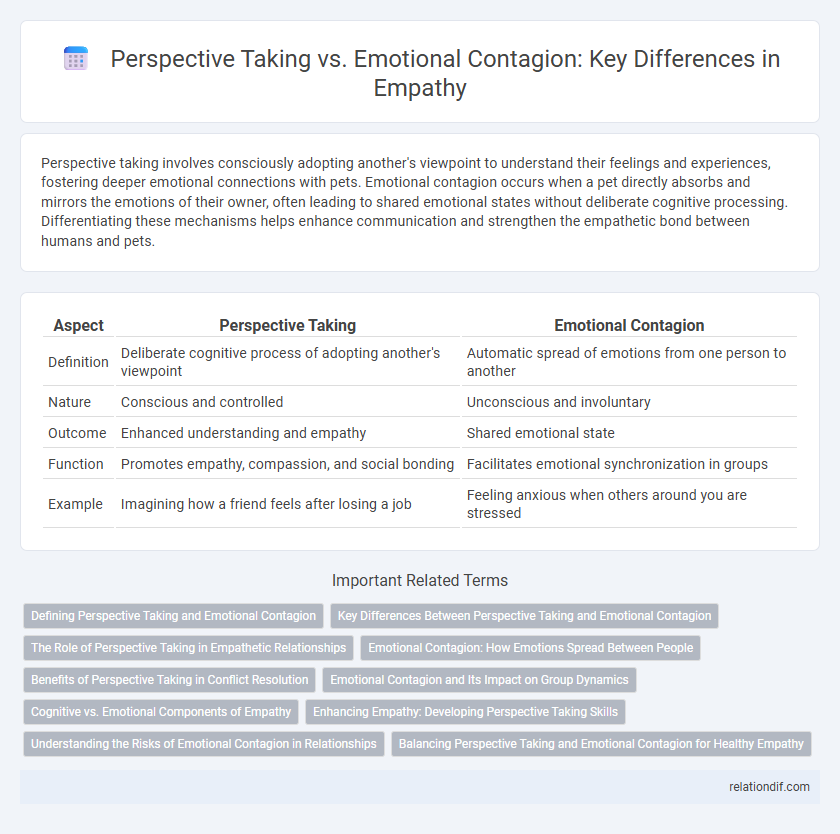Perspective taking involves consciously adopting another's viewpoint to understand their feelings and experiences, fostering deeper emotional connections with pets. Emotional contagion occurs when a pet directly absorbs and mirrors the emotions of their owner, often leading to shared emotional states without deliberate cognitive processing. Differentiating these mechanisms helps enhance communication and strengthen the empathetic bond between humans and pets.
Table of Comparison
| Aspect | Perspective Taking | Emotional Contagion |
|---|---|---|
| Definition | Deliberate cognitive process of adopting another's viewpoint | Automatic spread of emotions from one person to another |
| Nature | Conscious and controlled | Unconscious and involuntary |
| Outcome | Enhanced understanding and empathy | Shared emotional state |
| Function | Promotes empathy, compassion, and social bonding | Facilitates emotional synchronization in groups |
| Example | Imagining how a friend feels after losing a job | Feeling anxious when others around you are stressed |
Defining Perspective Taking and Emotional Contagion
Perspective taking involves cognitively adopting another person's viewpoint to understand their thoughts and feelings without necessarily sharing their emotional state. Emotional contagion refers to the automatic, often unconscious process of mimicking and synchronizing emotions with others, leading to shared affective experiences. While perspective taking engages deliberate mental effort to comprehend another's experience, emotional contagion occurs through affective resonance and social mimicry.
Key Differences Between Perspective Taking and Emotional Contagion
Perspective taking involves actively imagining another person's thoughts and feelings, requiring cognitive effort to understand their unique viewpoint. Emotional contagion is an automatic, unconscious process where an individual absorbs and mirrors the emotions of others without deliberate thought. The key difference lies in cognitive engagement--perspective taking is a deliberate mental act, while emotional contagion occurs spontaneously through social and emotional cues.
The Role of Perspective Taking in Empathetic Relationships
Perspective taking enhances empathetic relationships by enabling individuals to cognitively understand another person's thoughts and feelings, fostering deeper emotional connections. Unlike emotional contagion, which involves automatically mirroring another's emotions, perspective taking requires intentional mental effort to appreciate different viewpoints. This cognitive process reduces misunderstandings and promotes compassion, trust, and effective communication in social interactions.
Emotional Contagion: How Emotions Spread Between People
Emotional contagion refers to the automatic and unconscious process by which emotions spread from one person to another through nonverbal cues such as facial expressions, tone of voice, and body language. This phenomenon plays a crucial role in social interactions by synchronizing emotional states within groups, facilitating empathy, and enhancing social bonding. Studies in neuroscience reveal that mirror neuron systems activate during emotional contagion, enabling individuals to internally simulate others' feelings and respond emotionally in tandem.
Benefits of Perspective Taking in Conflict Resolution
Perspective taking enhances conflict resolution by enabling individuals to understand opponents' viewpoints, reducing misunderstandings and fostering mutual respect. This cognitive approach promotes collaborative problem-solving and decreases emotional reactivity that often arises from emotional contagion. By prioritizing perspective taking, conflicts are more likely to be resolved constructively, leading to durable agreements and improved interpersonal relationships.
Emotional Contagion and Its Impact on Group Dynamics
Emotional contagion involves the automatic synchronization of emotions within a group, significantly shaping group dynamics by fostering emotional unity or tension. This process can amplify collective moods, influencing decision-making, cooperation, and conflict resolution among members. Understanding emotional contagion is crucial for managing group environments effectively and promoting positive social interactions.
Cognitive vs. Emotional Components of Empathy
Perspective taking involves the cognitive component of empathy, enabling individuals to understand another person's thoughts and viewpoints without necessarily sharing their emotions. Emotional contagion pertains to the emotional component, where one automatically mirrors and feels another person's emotions, often unconsciously. Distinguishing these components is crucial for effectively employing empathy in social interactions and emotional regulation.
Enhancing Empathy: Developing Perspective Taking Skills
Developing perspective-taking skills enhances empathy by allowing individuals to cognitively understand others' thoughts and feelings without becoming overwhelmed by emotional contagion, which occurs when one automatically mirrors another's emotions. Training in perspective taking improves social cognition, emotional regulation, and conflict resolution by fostering mindful recognition of different viewpoints. Research shows that perspective-taking interventions increase emotional intelligence and promote prosocial behavior, supporting stronger interpersonal connections and empathy.
Understanding the Risks of Emotional Contagion in Relationships
Perspective taking involves cognitively adopting another person's viewpoint to understand their emotions, while emotional contagion is the automatic, unconscious sharing of feelings between individuals. Emotional contagion can pose risks in relationships by amplifying negative emotions, leading to increased stress and potential misunderstandings. Developing awareness of emotional boundaries and practicing perspective taking helps mitigate these risks, fostering healthier interpersonal connections.
Balancing Perspective Taking and Emotional Contagion for Healthy Empathy
Balancing perspective taking and emotional contagion is essential for cultivating healthy empathy, as it allows individuals to understand others' experiences without becoming overwhelmed by their emotions. Perspective taking involves cognitively adopting another's viewpoint, fostering compassion and problem-solving, while emotional contagion entails the automatic sharing of feelings, which can lead to emotional burnout if unchecked. Integrating both processes with self-awareness enables empathetic engagement that supports emotional boundaries and effective interpersonal connections.
Perspective taking vs emotional contagion Infographic

 relationdif.com
relationdif.com